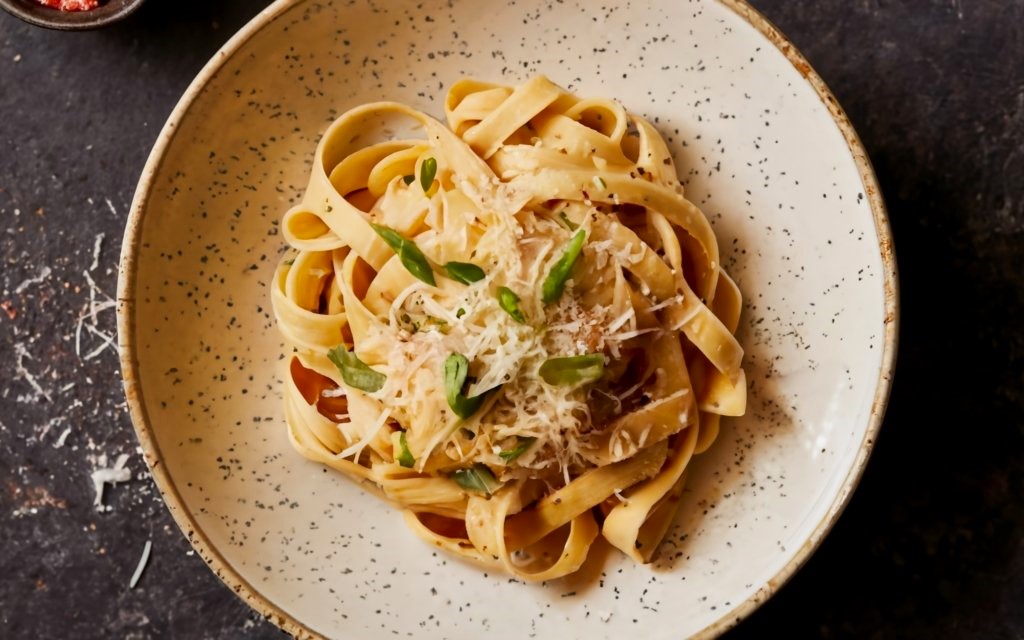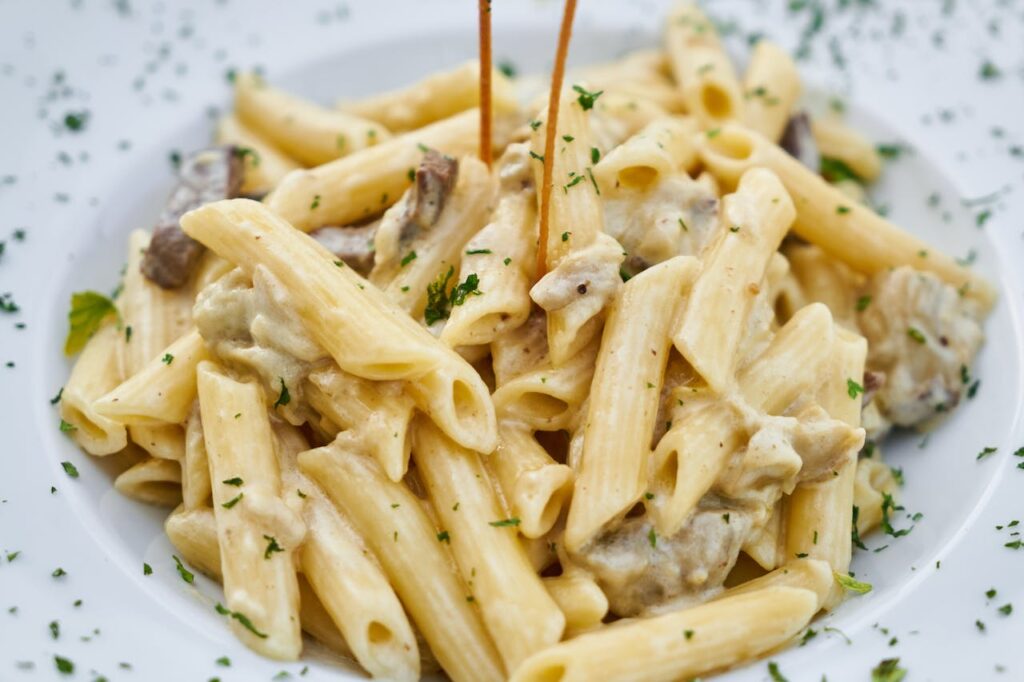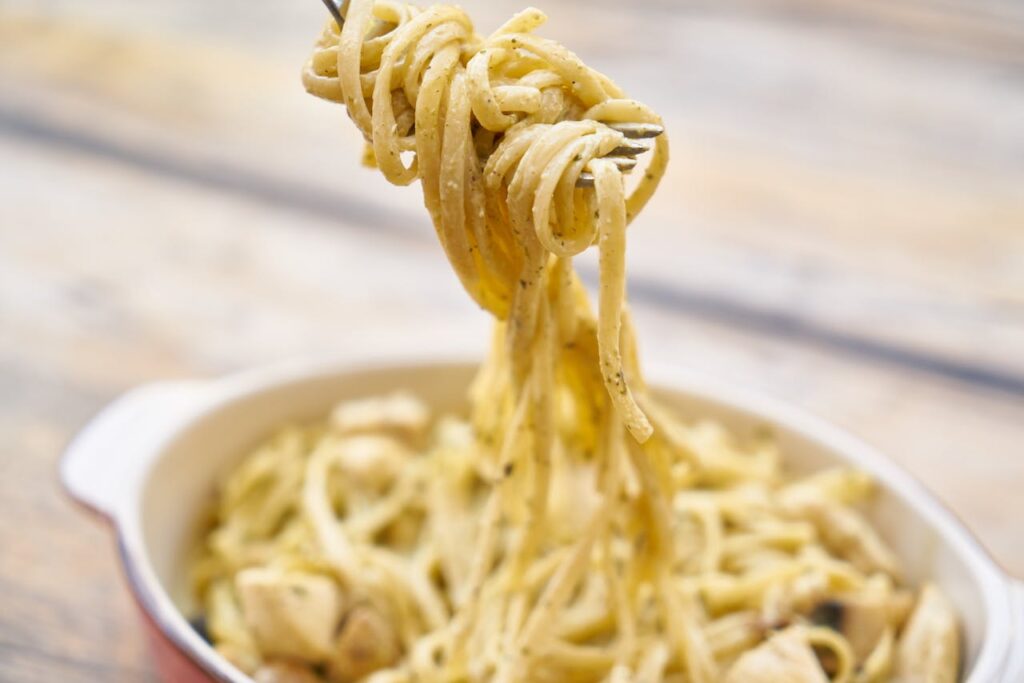Cacio e pepe (pronounced ka-choh eh peh-peh) is a delightful Italian pasta dish that translates to “cheese and pepper” in English. It’s a simple yet flavorful recipe made with pasta, Pecorino Romano cheese, black pepper, and a few pantry staples. This dish tastes creamy, cheesy, and has a kick of black pepper. It’s rich in flavor but straightforward in its ingredients.

Table of Contents
Step by Step: Cacio e Pepe Recipe
Ingredients:
- 8 ounces of pasta (such as spaghetti or bucatini)
- 1 cup grated Pecorino Romano cheese
- 2 teaspoons freshly ground black pepper
- Salt (for pasta water)
- Extra Pecorino Romano (optional, for garnish)
Making the Pasta:

- Boil the Pasta:
- Bring a pot of water to a boil. Add a pinch of salt.
- Put the pasta in the boiling water and cook until it’s firm but not too soft, following the time on the pasta package.
- Save Pasta Water:
- Before draining the pasta, reserve about 1 cup of the pasta water in a separate bowl. Keep it aside.
- Prepare the Pepper:
- Take a large skillet and put it over medium heat.
- Add the freshly ground black pepper to the skillet and toast it for about a minute. Stir occasionally until you can smell the pepper.
- Combine Pasta and Pepper:
- Once the pasta is cooked, transfer it directly into the skillet with the toasted pepper using tongs or a pasta fork. Keep the heat on medium-low.
- Add Cheese:
- Gradually sprinkle the grated Pecorino Romano cheese over the pasta while continuously tossing it. Use one hand to sprinkle and the other to toss.
- Create the Sauce:
- Pour a little of the reserved pasta water over the pasta while stirring continuously. This helps create a creamy sauce that coats the pasta.
- Serve:
- Keep tossing the pasta until the cheese melts and forms a creamy sauce that coats the pasta strands evenly.
- Once the sauce looks creamy and the cheese has melted beautifully, it’s ready to serve!
- Optional Garnish:
- If you’d like, sprinkle some extra Pecorino Romano cheese on top before serving.
Additional Tips:
- Keep Tossing: Continuously tossing the pasta while adding cheese and pasta water ensures the sauce coats the pasta evenly.
- Adjust Consistency: If the sauce seems too dry, add a bit more pasta water gradually until you reach the desired creamy consistency.
- Serve Immediately: Cacio e pepe is best enjoyed right after it’s made while it’s hot and creamy.
- Storage: If you have leftovers, store them in an airtight container in the refrigerator for up to two days. Reheat gently on the stovetop, adding a splash of water to regain the creamy texture.
Yield, Prep time and Calories
- Yield: This recipe typically yields about 2-3 servings, depending on portion size.
- Preparation Time: The preparation time for cacio e pepe is approximately 15-20 minutes, considering the time needed for boiling pasta, toasting pepper, and combining ingredients.
- Calories per Serving: A serving of cacio e pepe (approximately 1/3 of the prepared recipe) usually contains around 400-500 calories, but this can vary based on the specific ingredients used and portion sizes.
| Yield | Preparation Time | Approximate Calories per Serving |
|---|---|---|
| 2-3 servings | 15-20 minutes | 400-500 calories (approx. 1/3 of the recipe) |
What to Serve with Cacio e Pepe?

Here are some side dish ideas for what you can serve with cacio e pepe:
- Simple Green Salad: Prepare a fresh salad with lettuce, tomatoes, cucumbers, and your favorite dressing. The crispness of the salad contrasts well with the creamy pasta.
- Roasted Vegetables: Roast some vegetables like broccoli, cherry tomatoes, or zucchini in the oven with olive oil, salt, and pepper until they’re slightly crispy. They add a nice texture and flavor to the meal.
- Garlic Bread: Toast slices of bread and spread some garlic butter on top. It’s a classic side that complements the flavors of cacio e pepe.
- Grilled Chicken or Shrimp: Cook some chicken or shrimp on the grill or in a pan with your favorite seasonings. The protein pairs well with the pasta.
- Steamed Asparagus or Green Beans: Steam some asparagus or green beans until they’re tender but still crisp. They’re a simple and healthy addition to the meal.
- Bruschetta: Toasted bread topped with a mixture of diced tomatoes, garlic, basil, olive oil, and balsamic vinegar. It’s a refreshing side dish.
How to Make the Cacio e Pepe Sauce
- Heat the Pan:
- Take a large frying pan and put it on the stove over medium heat.
- Toast the Black Pepper:
- Add the freshly ground black pepper to the pan.
- Let it toast for about a minute while stirring gently. You’ll notice a nice aroma coming from the pepper.
- Add the freshly ground black pepper to the pan.
- No Oil Needed:
- There’s no need to add any oil or butter. The pepper will release its flavors on its own.
That’s it! Once you’ve toasted the black pepper, your sauce base is ready to combine with the cooked pasta later on.
Enjoy your homemade cacio e pepe! It’s a classic Italian dish that’s simple to make but bursting with flavor.
You Might Also Like: Gnocchi Recipe
FAQs
What does “cacio e pepe” mean?
“Cacio e pepe” translates to “cheese and pepper” in English. It’s a classic Italian pasta dish made with simple ingredients like pasta, Pecorino Romano cheese, and black pepper.
How do you pronounce “cacio e pepe”?
It’s pronounced as “ka-choh eh peh-peh.”
Can I use other types of cheese for cacio e pepe?
Traditionally, Pecorino Romano cheese is used for its sharp and salty flavor. However, you can experiment with other hard, salty cheeses like Parmesan if you prefer or have dietary restrictions.
Why is pasta water important in this recipe?
The starchy pasta water helps create a creamy sauce when combined with the cheese. It helps bind the cheese and pepper to the pasta, creating that signature creamy texture in cacio e pepe.
How can I prevent the cheese from clumping in the sauce?
To prevent clumping, it’s essential to gradually add the grated cheese while tossing the pasta continuously. Also, make sure the heat is on low or medium-low to melt the cheese slowly and evenly.
Can I store leftovers of cacio e pepe?
Yes, you can store leftovers in an airtight container in the refrigerator for up to two days. Reheat gently on the stove with a splash of water to retain the creamy texture.
What pasta shapes work best for cacio e pepe?
Long pasta shapes like spaghetti or bucatini are commonly used for cacio e pepe. Their texture allows the cheese and pepper to cling to the strands, but you can experiment with other shapes too.
What can I serve with cacio e pepe to make a complete meal?
You can serve cacio e pepe with a simple green salad, roasted vegetables, garlic bread, or a protein like grilled chicken or shrimp to create a well-rounded meal.



Pingback: Delicious Pasta all'Arrabbiata Recipe: A Spicy Italian Delight! 2024 - Gaze Bloom